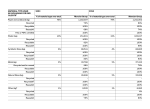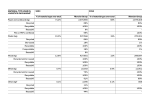THE NEW MONCLER INVESTOR RELATIONS APP IS NOW AVAILABLE
THE NEW MONCLER INVESTOR RELATIONS APP IS NOW AVAILABLE
The Moncler Group is committed to reducing packaging materials, as well as to researching and adopting lower-impact alternatives compared to conventional solutions. In recent years, the Group has also launched several programmes to improve packaging design, with a particular focus on recyclability and reusability1. All packaging products for end clients and used in logistics processes are made with “preferred” materials.
For logistical and production packaging, as well as the one intended for the end-client, and for use in the offices, since 2021 the Group has introduced a Manual, developed with the technical support of experts and in line with international standards, which defines the guidelines for the selection of “preferred” materials to be used for the creation of packaging and display items used in stores and window displays, with the aim of guiding all functions at Moncler and Stone Island that are responsible for designing and selecting these items.
The guidelines are based on key principles, including:
• reducing the amount of materials used;
• simplifying the structure of products with a view to eco-design by favouring mono-material or easily disassembled articles to promote reuse and recyclability;
• reducing the use of virgin raw materials, especially if from fossil origin, by favouring materials from renewable sources or recycling;
• designing items that can be used for a long time, re-used and recycled;
• selecting materials that have a validated environmental performance supported by documentary evidence and measurements, and, where possible, certified;
• using only materials that comply with the Group’s
Restricted Substances List (RSL).
These guidelines have been shared with all the heads of department involved in their implementation and application in the areas of creativity and design, purchasing, research and development, sustainability and communication, through specific training sessions.
In order to promote recyclability, where possible, the use of a single material for the packaging of each item has been foreseen and at the Castel San Giovanni (Piacenza) logistics hub a recycling process was implemented, involving a private partner operating at the facility to ensure proper, effective management of the recycling of packaging materials. Moreover, Group’s offices and stores are equipped with special waste sorting containers and employees are informed of the importance of using proper practices so that waste can be recycled/recovered or, to a residual extent, disposed of. In 2024, 80% of the materials used for packaging (both logistical and intended for end clients) were both recyclable and recycled.
Regarding reusability1, 79% of the packaging intended for end clients was reusable, showing an increase compared with 2023 (72%).
The Group is committed, where feasible, to furtherly and continuously reduce year after year the volume of its packaging in order to improve the environmental performance of its products. Among initiatives to reduce weight and materials used, Stone Island, in 2021, replaced the traditional stone paper used for its shopping bags with recycled paper, resulting in a 35% reduction in the weight of each bag. Furthermore, over the years the Group has eliminated the single-use plastic packaging used for the logistic transport of shoes, and a procedure has been introduced to optimise the amount of packaging used for the
internal shipment of samples of fabric and accessories between the various corporate functions, with consequent savings in the materials used. In addition, bands were eliminated from the Group’s logistics packaging in 2023.
For years, Moncler’s e-commerce channel has allowed clients to choose between two types of packaging made from “preferred” materials:
– “Signature” packaging: products are presented in a reusable Moncler box, tied with a tricolour ribbon. The external logistics box is made from 100% recycled paper from responsibly managed forests, while the inner box is composed of over 50% recycled sources. The inner garment covers, as well as the hangers, included with the down jackets, are made from post-consumer recycled plastic materials. In addition, last-mile delivery is done through the “UPS® carbon neutral” service for the Americas and EMEA Regions, whereas for Korea and Japan Moncler neutralises emissions through compensating projects;
– “Moncler Born To Protect” packaging (used for 80% of orders in 2024) that uses a reduced number of packaging layers, packaging products with lightweight and reusable materials. The external logistics box is always made from 100% recycled paper from responsibly managed forests, while the inner bags, as well as the hangers, are made of post-consumer recycled plastic. For this type of packaging as well, last-mile delivery takes place through the “UPS® carbon neutral” service for the Americas and EMEA Regions, with emissions compensating in Korea and Japan.
Despite the excellent results achieved, the Group is looking for continuous improvement. For this reason, annual R&D investments are allocated to explore and identify solutions with a lower environmental impact, also with the collaboration and assistance of international start-ups.
Regarding the application of alternatives with a lower impact compared to conventional ones, for the materials used in total packaging2, for both Moncler and Stone Island, 72% consists of paper and cardboard sourced from responsibly managed forests and made from 84% recycled
materials (2 percentage points more than in 2023). Approximately 17% of the materials used in the Group’s packaging are plastic, made from 99% recycled and 1% bio-based and compostable materials. Since 2023, all single-use virgin plastic from fossil origin has been
eliminated. The third most used material (7%) is wood, represented by reused logistics pallets. The remaining materials include synthetic fibres, 100% recycled; natural materials; artificial materials; and metals and other. In particular:
Since 2022, all of the Moncler Group’s packaging for end clients has been made from “preferred” and mostly reusable3 materials, made to last. In particular, all paper6 and cardboard come from responsibly managed forests (FSC and PEFC certification) and are made from 84% recycled materials, 12 percentage points higher than last year. This increase was mainly achieved by switching to 100% recycled paper for the hangtags and for
the button bags of the Moncler Collection.
The second most used material is plastic, 100% recycled and reusable3. In particular, accessories such as the garment covers zippers and bags used in the e-commerce channel are made from recycled plastic, as well as hangers, which have been redesigned with a removable hook, thus promoting a correct recycling process. In 2024, moreover, the Moncler Group transitioned from purchasing hangers made from
100% pre-consumer recycled plastic to those made from 100% post-consumer recycled plastic.
The third most used material for packaging for end clients is synthetic fibres 100% recycled, used for garment bags as well as for accessory and knitwear bags.
Natural fabrics, almost entirely represented by certified organic cotton, are mainly used for all accessories bags.

The materials most used for the Group’s logistic packaging are paper and cardboard from responsibly managed forests (FSC or PEFC
certification) and 84% made up from recycled materials.
Plastic is 99% recycled and 1% compostable and
bio-based.
Since 2023, all the packaging used in logistics consists only of “preferred” materials.

The impact of plastic on the environment, especially single-use virgin plastic, has become a very important issue for the planet. The Group progressively reduced the use of single-use virgin plastic from fossil origin until its complete phase out in 2023.
To date, 99% of the single-use plastic ordered
by the Group consists of recycled plastic, and 1% of compostable and bio-based plastic.
The decision to replace single-use virgin plastic with mainly recycled plastic stems from a Life Cycle Assessment conducted with Politecnico of Milan to identify the best alternative from an environmental and technical-performance point
of view. This analysis showed that recycled plastic reduces CO2 emissions by 35% and water consumption by 60% compared to virgin plastic. In addition to preferring recycled plastics, the weight of many single-use items was reduced by 10%, thus allowing a reduction in unit weight and a decrease in the use of raw materials.
All the paper and cardboard used by the Group come from responsibly managed forests (FSC or PEFC). Given their significant use, these materials
are constantly the focus of improvement projects, linked to the reduction of their use where possible and to the increase in the percentage
of recycled material.
To date, 72% of the Group’s paper is made from recycled material.
NOTES
1 This refers to the ability of a product to be used multiple times or in multiple contexts without losing its functionality, performance or quality.
2 Includes the packaging used for logistics, production, end clients and offices, ordered in 2024.
3 Recyclable but not through municipal collection system.
4 Composite materials that cannot be separated.
5 Packaging intended for end clients ordered in 2024.
6 Paper is mainly used for shopping bags, whose paper is 100% recycled, for gift boxes, tags and shoe boxes.
7 Logistics packaging ordered in 2024.
8 Includes total single-use plastics ordered in 2024, not just the one used for packaging.
9 Includes the total paper ordered in 2024, not just the one used for packaging.